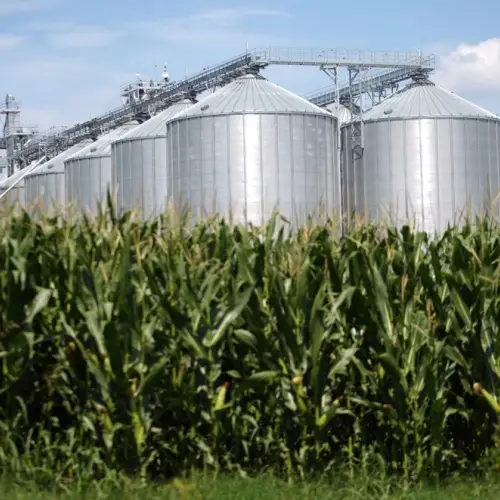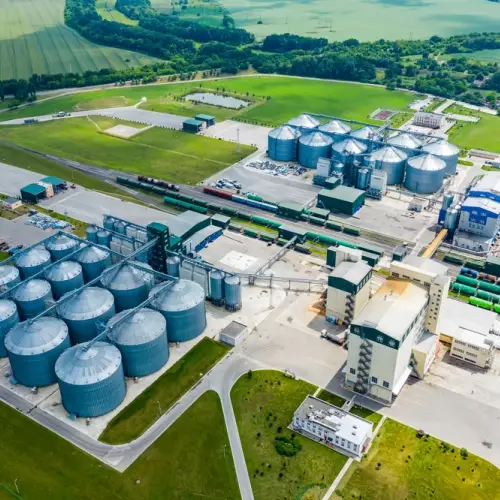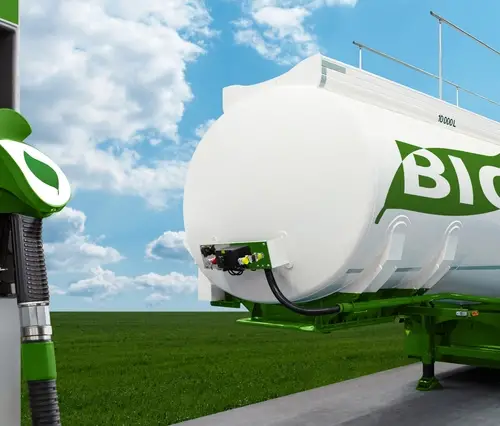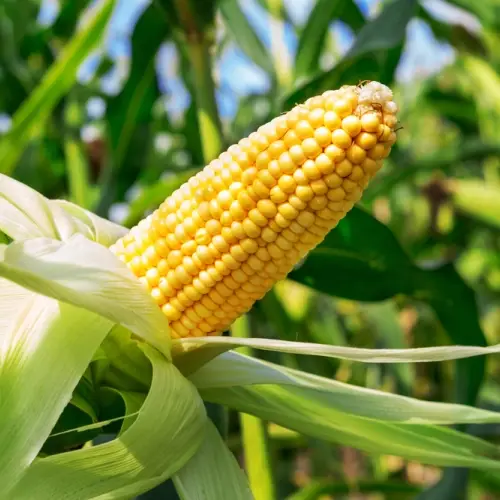
Biofuels are fuels obtained from plant or animal biomass. They can be derived from agricultural crops, such as palm oil, sugarcane, soybeans, corn, or organic waste.
Its main function is to serve as an alternative to fossil fuels in internal combustion engines and other energy processes.
Characteristics of biofuels
 Organic origin : They are produced from renewable organic matter in relatively short periods.
Organic origin : They are produced from renewable organic matter in relatively short periods.- Sustainability questioned : Although they are promoted as a greener alternative, their environmental impact depends on the production process.
- Diversity of types : They can be classified according to their source of origin and production technology.
- Use in conventional engines : Many biofuels can be blended with traditional fuels without modifying the engines.
- Variable emissions : Some reduce the emission of certain pollutants, but others can be even more harmful than fossil fuels.
Are biofuels renewable or non-renewable resources?
Biofuels are considered technically renewable, as they come from organic matter that can be regenerated in relatively short periods of time compared to fossil fuels.
However, its sustainability is questionable, as large-scale production can lead to problems such as deforestation, biodiversity loss, and greenhouse gas emissions.
Furthermore, the regeneration rate of crops used for biofuels is slower than their consumption rate, making them less viable in the long term compared to truly sustainable sources such as solar or wind power.
Obtaining and manufacturing process
The process of obtaining biofuels consists of 5 different phases:
1. Cultivation and harvesting of raw materials
Biofuels are produced from plant or animal-based feedstocks, such as energy crops (corn, sugarcane, soybeans), agricultural waste, used oils, and forest biomass. These feedstocks are grown and harvested following specific agricultural practices to maximize biomass production.
2. Processing and extraction
Once collected, the raw materials undergo extraction processes to obtain the essential components for biofuel production.
In the case of vegetable oils, they are extracted by pressing or solvents, while lignocellulosic biomass undergoes physical and chemical processes to break down its structures.
3. Conversion into biofuel
The extracted material is converted into biofuel through various processes.
For liquid biofuels, such as biodiesel, the transesterification of vegetable oils or animal fats is used, while bioethanol is obtained by fermentation of sugars. In the case of biogas, organic matter is decomposed through anaerobic digestion, producing methane usable as fuel.
4. Purification and refinement
 The raw biofuel obtained must undergo purification processes to remove impurities and improve its quality.
The raw biofuel obtained must undergo purification processes to remove impurities and improve its quality.
This may include distilling ethanol to increase its concentration, filtering biodiesel, or removing contaminants from biogas to make it suitable for use in engines and distribution networks.
5. Distribution and use
Once refined, biofuels are stored and distributed for use in various sectors, such as transportation, electricity generation, and heating. In some cases, they can be used neat or blended with fossil fuels to optimize their performance and compatibility with conventional engines.
Types of biofuels
Biofuels are a renewable energy source obtained from biomass and can be used as an alternative to fossil fuels. The most common types include:
1. Bioethanol
Bioethanol is a liquid biofuel used as a substitute or additive for gasoline in internal combustion engines. It is obtained through the fermentation of sugars found in crops such as sugarcane, corn, wheat, and beets.
Its use reduces dependence on petroleum and reduces the emission of certain atmospheric pollutants, although its intensive production has generated debate due to its impact on land use and food availability.
2. Biodiesel
 Biodiesel is an alternative to diesel produced from vegetable oils, such as those extracted from sunflower, rapeseed, palm, and soybeans, as well as from animal fats and recycled oils.
Biodiesel is an alternative to diesel produced from vegetable oils, such as those extracted from sunflower, rapeseed, palm, and soybeans, as well as from animal fats and recycled oils.
Its manufacture is based on a chemical process called transesterification, which converts triglycerides into methyl or ethyl esters of fatty acids.
Its combustion generates fewer sulfur and particulate emissions compared to fossil diesel, although the expansion of oilseed crops for its production has been criticized for its impact on deforestation and biodiversity.
3. Biogas
Biogas is a gaseous fuel composed primarily of methane and carbon dioxide, generated by the anaerobic decomposition of organic matter, such as agricultural waste, manure, sewage sludge, and urban waste.
It can be used for electricity generation, heating, and as a vehicle fuel, after purification. Its production contributes to waste management and the reduction of methane emissions, a potent greenhouse gas.
4. Biomethane
Biomethane is a refined version of biogas, obtained by removing impurities and increasing the methane concentration to levels comparable to natural gas. This allows its injection into distribution networks and its use in vehicles powered by compressed natural gas (CNG).
Its development is growing as a sustainable alternative in mobility and industry.
Generations of biofuels
 Since its emergence, biofuel production technology has evolved, dividing into different generations:
Since its emergence, biofuel production technology has evolved, dividing into different generations:
- First generation : They are produced from food crops, such as corn and sugar cane, generating competition with food production.
- Second generation : Derived from lignocellulosic biomass, such as agricultural and forestry residues, which reduces pressure on food crops.
- Third generation : They are produced from algae, which can generate high oil yields without affecting food production.
- Fourth generation : They use non-arable lands and genetically modified organisms to optimize biofuel production.
Environmental impact and relationship with climate change
The use of biofuels has been promoted as a more sustainable alternative to fossil fuels due to their renewable origin and potential to reduce CO₂ emissions.
However, their environmental impact is a subject of debate, as the production, processing, and distribution of these fuels can have negative effects on the environment.
Carbon footprint and emissions
Although biofuels emit less carbon dioxide (CO₂) during combustion than fossil fuels, their full life cycle may not be as beneficial as previously thought. Growing raw materials requires large amounts of water, fertilizers, and energy, which can generate indirect greenhouse gas emissions. Furthermore, the use of agricultural machinery and the transportation of biofuels can increase their carbon footprint.
Effect of nitrogen oxides
According to Nobel Prize winner in Chemistry Paul Crutzen, some biofuels can contribute to global warming due to the emission of nitrogen oxides (NOx), which have a much greater global warming potential than CO₂.
During biofuel production, the use of nitrogen fertilizers on crops releases nitrous oxide (N₂O), a greenhouse gas up to 300 times more potent than CO₂ in terms of heat retention in the atmosphere.
Deforestation and loss of biodiversity
The rising demand for biofuels has led to the expansion of monoculture crops such as soybeans and oil palm, resulting in the deforestation of tropical rainforests and the loss of biodiversity.
In regions such as the Amazon and Southeast Asia, large tracts of forest have been cleared to make way for plantations for biodiesel and bioethanol production, reducing the capacity of natural ecosystems to absorb CO₂.
Impact on food security
Competition between biofuel crops and food crops has raised concerns about food security.
By converting agricultural land to biofuel crops instead of food, prices for staples like corn and wheat have risen, particularly affecting the most vulnerable populations.
Energy Return Rate (EROR)
The Energy Return on Investment (EROI) of biofuels varies depending on the type and production process. First-generation biofuels are generally considered to have a low EROI, close to 1 or even lower in some cases.
This means that the amount of energy used in their production may be similar to or greater than the energy they generate when used.
Some approximate EROEI values for biofuels are:
- Corn bioethanol: Between 0.8 and 1.5 (depending on the production method and the place of cultivation).
- Sugarcane bioethanol: It can reach 8 in some cases, such as in Brazil, where the process is more efficient.
- Soy biodiesel: Between 1 and 3.
- Palm biodiesel: Approximately 3.
These values can improve with technological advancements and the use of second- and third-generation raw materials, such as agricultural waste or algae.
However, compared to fossil fuels such as petroleum (which historically had an EROEI of 100 in its early days and is currently around 20-30), biofuels still have a relatively low energy efficiency.
Difference between biofuels and agrofuels
Initially, the prefix "bio" in biofuels was used to highlight their organic origin in contrast to fossil fuels. However, many companies have used the term "bio" to indicate a supposed ecological benefit that is, in some cases, questionable.
For this reason, some environmental organizations prefer the term "agrofuels," which emphasizes their agricultural origin and highlights the problems associated with using farmland to produce energy instead of food.